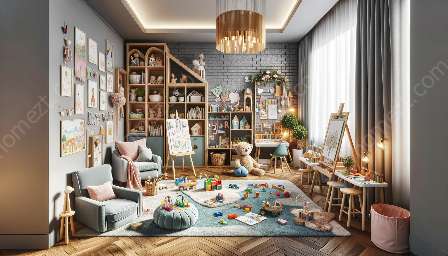Imaginary play, also known as pretend play, is a crucial component of childhood development that allows children to explore their creativity, problem-solving skills, and emotional intelligence. In this comprehensive guide, we will delve into the enchanting world of imaginary play and how it harmonizes with playroom activities and nursery design.
The Power of Imaginary Play
Imaginary play is a type of play where children use their imaginations to create scenarios, characters, and settings, often without any props or specific guidelines. This unstructured form of play cultivates crucial skills such as:
- Creativity: Imaginary play encourages children to think outside the box, fostering their ability to imagine and invent new worlds and situations.
- Empathy: Acting out different roles and scenarios helps children develop empathy and understanding of others' perspectives.
- Problem-Solving: Children use their imaginative play to navigate and resolve conflicts, enhancing their problem-solving capabilities.
The Imaginary Playroom
One of the most effective ways to facilitate imaginary play is by designing a playroom that sparks children's creativity and imagination. A well-crafted playroom offers various opportunities for imaginary play and complements nursery design, creating a harmonious environment for young minds to flourish.
Creating an Enchanting Playroom Atmosphere
When designing a playroom, it's essential to incorporate elements that inspire imaginary play. This can include:
- Themed Play Areas: Designing specific areas in the playroom, such as a cozy reading nook or a make-believe kitchen, can encourage children to immerse themselves in different roles and scenarios.
- Open-ended Toys: Providing toys and materials that can be used in multiple ways encourages imaginative play. Blocks, dress-up costumes, and art supplies are excellent choices for nurturing creative expression.
- Interactive Learning Spaces: Incorporating interactive elements, such as chalkboard walls or sensory play tables, cultivates a hands-on approach to learning and imaginative exploration.
Fostering Social Interaction
Imaginary play often involves teamwork and collaboration, making the playroom an ideal setting for children to engage with their peers. Group activities, such as creating a pretend city using blocks or putting on a play with dress-up costumes, can enhance children's social skills and cooperative play.
Playroom Activities That Promote Imaginative Play
While the playroom serves as an imaginative sanctuary, incorporating specific activities can further ignite children's creativity and curiosity. Here are some captivating playroom activities to foster imaginary play:
- Storytelling and Puppet Shows: Encourage children to create and act out their stories using puppets or props, allowing them to bring their narratives to life.
- Exploration Stations: Set up different exploratory stations in the playroom, such as a sensory table or a nature-inspired corner, to pique children's curiosity and imaginative thinking.
- Role-Playing Dress-Up: Providing a variety of costumes and props enables children to step into different roles and ignite their imagination, whether they're pretending to be astronauts, doctors, or fairy-tale characters.
The Transformative Impact of Imaginary Play
Imaginary play not only unleashes the boundless creativity within children but also lays the foundation for essential developmental skills. As children immerse themselves in imaginative scenarios and engage in playroom activities, they enhance their cognitive, emotional, and social competence, preparing them for a lifetime of learning and exploration.


